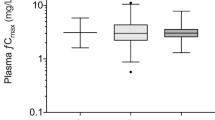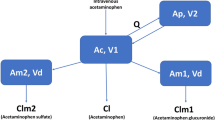Abstract
A descriptive profile for antipyretic drug action has been documented for children. However, a linked pharmacokinetic–pharmacodynamic (PK/PD) model is central to the understanding of antipyretic drug action in febrile children. This was examined for previously reported data from 178 febrile children who received a single oral dose of acetaminophen (APAP) (12.5 mg/kg), ibuprofen (IBU) (5 or 10 mg/kg), or placebo. Rectal temperatures and plasma levels (μg/ml) of APAP and IBU were measured for up to 12 hr after drug administration. Nonlinear regression analyses were applied to these measurements and yielded simultaneous solutions of an integrated one-compartment PK, link, and SigmoidEmax effect model in 102/153 febrile children given APAP or IBU. The PK parameters (tlag ,ka , β,T1 / 2β ,AUC0–∞ ,Vd/F,andClp/F) were not different than those reported previously, except the APAPka was significantly lower. The link component yieldedkeo s of 0.58±0.06 (X±SE), 0.70±0.11 and 0.57 ± 0.11 hr -1 for APAP, IBU05, and IBU10, respectively: the SigmoidEmax component yieldedEC50 s (μg/ml) and sigmoidicity (γ) of 4.63±0.39 and 3.98±0.42 for APAP, 11.33±1.35 and 3.97±0.58 for IBU05 and 12.83±1.89 and 4.27±0.63 for IBU10. On visual inspection of the efficacy–time profiles of the febrile children, a number of them had an apparent linear function (slope; Δ°C/hr) and/or a sinusoidal cyclic function “confounding” standard approaches to PD analysis. Thus, the temperature profiles of 91/102 children given APAP or IBU required the addition of a slope (Δ°C/hr) and/or a sinusoidal cyclic function to the SigmoidEmax component to fit the data satisfactorily. All 22 children given a placebo also required a slope and/or a cyclic function in their PD model. The residual Δ°Cs (observed-predicted) of the placebo group were not significantly different from 0. Thus, no placebo antipyretic effect was observed. Dose dependency of IBUAUC0–∞ was confirmed; doubling the dose from 5 to 10 mg/kg increased theAUC0→∞ by only 1.5-fold. The confounding effect of initial temperature (Tempi ) on antipyretic efficacy in all treatment groups except placebo was also confirmed to expose nonlinear pharmacodynamics. A significant (p=0.03) contribution ofTempi (but not age) on the value of the slope function was found. There was no consistent effect of age orTempi , on the cyclic component of the integrated model of antipyresis. In addition, a multiple linear relationship of age andTempi was observed with a large number of the PK, link, and PD variables in those who received IBU. Dose, age, andTempi interacted with β in a significant multiple linear relationship withAUC0–∞ . The effects of IBU dose, age, andTempi are pervasive and cascade down the chain of events leading to the PD response. The etiology of pyresis may create the slope function, the magnitude of which may be partially due to the underlying disease. In some cases, the cyclic function may be explained by temperature regulation. Regardless of their cause, both confound analysis of drug action and make the simple, unmodified SigmoidEMax effect model less than satisfactory for interpretation of antipyretic drug effects. The influence of Tempi on the magnitude of antipyretic drug response is also a finding with major impact on PD investigations of antipyretic medications. In children receiving IBU, dose and age are also confounders, in addition toTempi . A multiplicity of covariables must be taken into account when developing appropriate dosing regimens for these antipyretics in febrile children.
Similar content being viewed by others
REFERENCES
J. T. Wilson, R. D. Brown, G. L. Kearns, V. F. Eichler, V. A. Johnson, K. M. Bertrand, and B. A. Lowe, A single dose placebo-controlled comparative study of ibuprofen and acetaminophen antipyresis in children. J. Pediat. 119:803–811 (1991).
P. D. Walson, G. Galletta, N. J. Braden, and L. Alexander. Ibuprofen, acetaminophen, and placebo treatment of febrile children. Clin. Pharmacol. Ther. 46:9–17 (1989).
J. T. Wilson, R. D. Brown, J. A. Bocchini, Jr., and G. L. Kearns. Efficacy, disposition and pharmacodynamics of aspirin, acetaminophen and choline salicylate in young febrile children. Ther. Drug Monit. 4:147–180 (1982).
G. Heremans, F. Dehaen, N. Rom, J. Ramet, M. Verboven and H. Loeb. A single-blind parallel group study investigating the antipyretic properties of ibuprofen syrup vs. acetylsalicyclic acid syrup in febrile children. Br. J. Clin. Pract. 42(6):245–247 (1988).
McNeil Consumers Products Division, Labeling for Children's Motrin, Fort Washington, PA, 1996.
Wyeth-Ayerst Laboratories (Division of American Home Products Corporation). Labeling for Children's Advil (Ibuprofen) Suspension, Philadelphia, PA, (1996).
Pharmacy Today. Advisory committees recommend OTC status for pediatric ibuprofen. Pharm. Today 1(9):3 (1995).
Whitehall-Robins Healthcare (Division of American Home Products Corporation). Nonprescription Labeling for Children's Advil (Ibuprofen) Suspension, Madison, NJ, (1997).
R. D. Brown, J. T. Wilson, G. L. Kearns, V. F. Eichler, V. A. Johnson and K. M. Bertrand. Single dose pharmacokinetics of ibuprofen and acetaminophen in febrile children. J. Clin. Pharmacol. 32:231–241 (1992).
M. Kelley, P. Walson, J. Edge, S. Cox and M. Mortensen. Pharmacokinetics and pharmacodynamics of ibuprofen isomers and acetaminophen in febrile children. Clin. Pharmacol. Ther. 52:181–189 (1992).
SAS Institute, Inc. SAS/STAT User's Guide (6.03 edition) (and other appropriate manuals), SAS Institute, Inc., Cary, NC, 1988, p. 1028.
R. D. Brown, G. L. Kearns and J. T. Wilson. Integrated pharmacokinetic (PKN)/pharmacodynamic (PDN) model for acetaminophen and ibuprofen antipyresis in children. Clin. Pharmacol. Ther. 53:147 (1993).
L. B. Sheiner. Differential weighting with two types of observations (Lecture 4). In L. B. Sheiner and M. Rowland (eds.), The Fifth One-Week Workshop on Advanced Methods in Pharmacokinetics/Pharmacodynamics, University of California Press, San Francisco, 1988, pp. 17; 23–27.
L. B. Sheiner, D. R. Stanski, S. Vozeh, R. M. Miller and J. Ham. Simultaneous modeling of pharmacokinetics and pharmacodynamics: Application to d-tubocurarine. Clin. Pharmacol. Ther. 25:358–371 (1979).
R. D. Brown, G. L. Kearns and J. T. Wilson. A model of apparent antipyresis in placebo-treated febrile children. Clin. Pharmacol. Ther. 55:178 (1994).
K. Yamaoka, T. Nakagawa and T. Uno. Application of Akaike's information criterion (AIC) in the evaluation of linear pharmacokinetic equations. J. Pharmacokin. Biopharm. 6:165–175 (1978).
Author information
Authors and Affiliations
Rights and permissions
About this article
Cite this article
Brown, R.D., Kearns, G.L. & Wilson, J.T. Integrated Pharmacokinetic–Pharmacodynamic Model for Acetaminophen, Ibuprofen, and Placebo Antipyresis in Children. J Pharmacokinet Pharmacodyn 26, 559–579 (1998). https://doi.org/10.1023/A:1023225217108
Published:
Issue Date:
DOI: https://doi.org/10.1023/A:1023225217108




